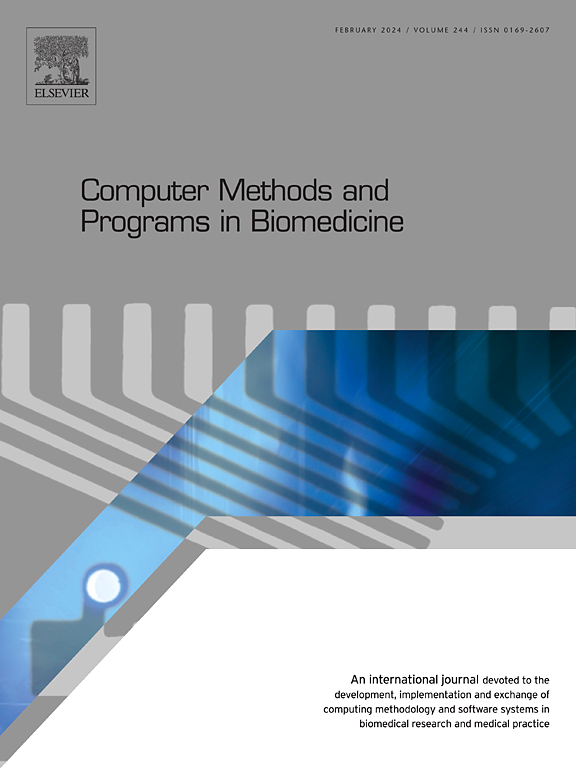用于分析生物医学图像中的管状结构的软件
IF 4.9
2区 医学
Q1 COMPUTER SCIENCE, INTERDISCIPLINARY APPLICATIONS
引用次数: 0
摘要
背景与目的血管的准确分割和建模是理解血管解剖和病理的关键。VesselKnife是专门开发的软件,用于解决半径估计和3D重建的挑战,特别是对于薄容器段和复杂的几何形状。本研究评估了该软件在医学成像应用中的准确性和通用性。方法vesselknife采用基于多尺度血管度函数和主成分分析的先进技术来估计血管半径和表征管腔方向。使用不同半径和噪声水平的管状结构的合成三维图像以及来自MRI和CT的真实医学成像数据验证了算法。定量性能指标,包括相对误差、精度和对噪声的鲁棒性进行了评估。结果该软件在综合数据实验中取得了较高的精度,对小血管的半径估计误差在2.3% ~ 5.7%之间,对大血管的半径估计误差在2.9%之间。该方法对噪声具有鲁棒性,并对细血管段进行了可靠的分割。在真实的成像场景中,VesselKnife可以有效地模拟大脑和肾脏血管系统。此外,该工具还应用于共聚焦显微镜和支架建模,说明了它对不同成像模式的适应性。结论vesselknife在不同的成像条件下具有精确的半径估计和稳健的性能,解决了血管建模中的关键空白。合成三维图像数据库的发布促进了再现性和进一步的研究。VesselKnife是生物医学成像研究人员和从业者的可靠工具,其潜在的应用范围超出了血管研究。本文章由计算机程序翻译,如有差异,请以英文原文为准。
VesselKnife – software for the analysis of tubular structures in biomedical images
Background and objective
Accurate segmentation and modeling of blood vessels are critical for understanding vascular anatomy and pathology. VesselKnife is specialized software developed to address challenges in radius estimation and 3D reconstruction, particularly for thin vessel segments and complex geometries. This study evaluates the software's accuracy and versatility in medical imaging applications.
Methods
VesselKnife incorporates advanced techniques based on multiscale vesselness functions and principal component analysis to estimate vessel radii and characterize lumen orientation. The algorithms were validated using synthetic 3D images of tubular structures with varying radii and noise levels, as well as real medical imaging data from MRI and CT. Quantitative performance metrics, including relative error, precision, and robustness to noise, were assessed.
Results
The software achieved high accuracy in synthetic data experiments, with radius estimation errors ranging from 2.3 % to 5.7 % for small vessels and up to 2.9 % for larger vessels. It demonstrated robustness to noise and provided reliable segmentation for thin vessel segments. In real imaging scenarios, VesselKnife was effective in modeling cerebral and renal vasculature. Additionally, the tool was applied to confocal microscopy and scaffold modeling, illustrating its adaptability to diverse imaging modalities.
Conclusions
VesselKnife addresses critical gaps in vascular modeling with precise radius estimation and robust performance across varying imaging conditions. The release of a synthetic 3D image database promotes reproducibility and further research. VesselKnife is a reliable tool for researchers and practitioners in biomedical imaging, with potential applications extending beyond vascular studies.
求助全文
通过发布文献求助,成功后即可免费获取论文全文。
去求助
来源期刊

Computer methods and programs in biomedicine
工程技术-工程:生物医学
CiteScore
12.30
自引率
6.60%
发文量
601
审稿时长
135 days
期刊介绍:
To encourage the development of formal computing methods, and their application in biomedical research and medical practice, by illustration of fundamental principles in biomedical informatics research; to stimulate basic research into application software design; to report the state of research of biomedical information processing projects; to report new computer methodologies applied in biomedical areas; the eventual distribution of demonstrable software to avoid duplication of effort; to provide a forum for discussion and improvement of existing software; to optimize contact between national organizations and regional user groups by promoting an international exchange of information on formal methods, standards and software in biomedicine.
Computer Methods and Programs in Biomedicine covers computing methodology and software systems derived from computing science for implementation in all aspects of biomedical research and medical practice. It is designed to serve: biochemists; biologists; geneticists; immunologists; neuroscientists; pharmacologists; toxicologists; clinicians; epidemiologists; psychiatrists; psychologists; cardiologists; chemists; (radio)physicists; computer scientists; programmers and systems analysts; biomedical, clinical, electrical and other engineers; teachers of medical informatics and users of educational software.
 求助内容:
求助内容: 应助结果提醒方式:
应助结果提醒方式:


